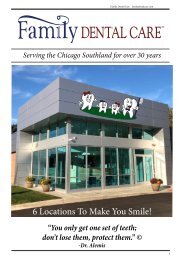Family Dental Care™ Magazine (2021 Edition)
2021 Edition from Family Dental Care™ in Chicago's Southland and NW Indiana
2021 Edition from Family Dental Care™ in Chicago's Southland and NW Indiana
You also want an ePaper? Increase the reach of your titles
YUMPU automatically turns print PDFs into web optimized ePapers that Google loves.
<strong>Family</strong> <strong>Dental</strong> Care familydentalcare.com <strong>Family</strong> <strong>Dental</strong> Care familydentalcare.com<br />
Arlene M.<br />
“I have been seeing Dr. Kondellas for almost 14 years and he is<br />
great. Very Patient. I have special requirements and he always<br />
pays attention. His staff is always polite. They attend to issues<br />
when the occur very quickly. The office is always clean and<br />
comfortable.”<br />
Restorative Dentistry<br />
Fillings, Crowns and Bridges<br />
What are Fillings?<br />
Fillings do just what the name implies — seal<br />
a small hole in your tooth (i.e. a cavity) caused by<br />
decay. This prevents the decay (a bacteria-induced<br />
infection) from spreading further into your tooth<br />
and, if untreated, continue on to the sensitive inner<br />
pulp (nerve) tissue located in the root canal. Should<br />
that happen, you would need root canal treatment.<br />
What are Crowns?<br />
Crowns are synthetic caps, usually made of a<br />
material like porcelain, placed on the top of a tooth.<br />
A crown completely covers a tooth above the gum<br />
line. This is in contrast to a dental veneer, which<br />
only covers a tooth’s front surface and needs natural<br />
tooth structure to support it. Therefore, if a tooth<br />
is missing a significant amount of structure above<br />
the gum line, a crown would be the restoration of<br />
choice.<br />
What are Bridges?<br />
Bridges are natural-looking dental appliances that can<br />
replace a section of missing teeth. Because they are custom-made,<br />
bridges are barely noticeable and can restore the natural contour<br />
of teeth as well as the proper bite relationship between upper and<br />
lower teeth.<br />
Crowns can be used in a bridge to create a lifelike replacement<br />
for a missing tooth. The bridgework spans the space<br />
of the missing tooth and requires at least three crowns. Two of<br />
those crowns will be placed over healthy teeth on either side of<br />
the missing tooth; these healthy teeth are referred to as abutment<br />
teeth. The two crowned abutment teeth become supports for a<br />
third crown placed in between them; that third crown is referred<br />
to as a pontic. If more than one tooth is missing, more crowns will<br />
be needed to bridge the gap in between the abutment teeth.<br />
The number of abutment teeth necessary to replace<br />
missing teeth is influenced by the number of missing teeth, the<br />
size, and length of the abutment tooth roots, the amount of bone<br />
support each abutment tooth has, as well as where in the mouth<br />
the missing tooth is located. For example, if you have three missing<br />
teeth, four abutment teeth may be necessary, thereby creating<br />
a seven-tooth bridge. Engineering and designing of the bridge<br />
require an understanding of how to replace teeth, as well as the<br />
biology of the supporting gum and bone tissue.<br />
Dr. Kondellas<br />
D.D.S.<br />
General Dentist<br />
General Dentist University of Illinois, College of Dentistry<br />
(1993)<br />
Member: ADA, CDS, ISDS, AGD<br />
Dr. Kondellas graduated from<br />
the University of Illinois<br />
College of Dentistry in 1993.<br />
Since joining <strong>Family</strong> <strong>Dental</strong><br />
Care over 20 years ago, he has worked<br />
at all of our offices, providing excellent<br />
dentistry to patients of all ages. Dr. Kondellas<br />
is zealous in continuing education,<br />
taking multiple courses to advance the<br />
field of dentistry as he stays up-to-date<br />
on the latest technologies. His patients<br />
are dedicated to returning to see him,<br />
year after year, for any dental needs they<br />
may have. Dr. Kondellas appreciates all<br />
phases of general dentistry and endeavors<br />
to enhance the lives of all his patients<br />
through improving their oral health.<br />
12 13




